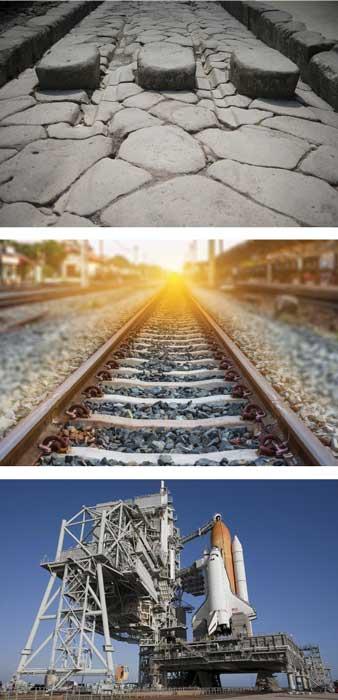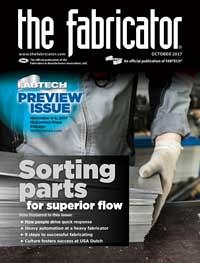- FMA
- The Fabricator
- FABTECH
- Canadian Metalworking
Categories
- Additive Manufacturing
- Aluminum Welding
- Arc Welding
- Assembly and Joining
- Automation and Robotics
- Bending and Forming
- Consumables
- Cutting and Weld Prep
- Electric Vehicles
- En Español
- Finishing
- Hydroforming
- Laser Cutting
- Laser Welding
- Machining
- Manufacturing Software
- Materials Handling
- Metals/Materials
- Oxyfuel Cutting
- Plasma Cutting
- Power Tools
- Punching and Other Holemaking
- Roll Forming
- Safety
- Sawing
- Shearing
- Shop Management
- Testing and Measuring
- Tube and Pipe Fabrication
- Tube and Pipe Production
- Waterjet Cutting
Industry Directory
Webcasts
Podcasts
FAB 40
Advertise
Subscribe
Account Login
Search
Change in metal fabrication: It is futile to resist
Base your procedures on physical realities, not tradition
- By Steve Benson
- October 24, 2017
- Article
- Bending and Forming
Over the past 30 years or so our industry has been making the shift from bottoming and coining to air forming on the press brake.
In many respects, air forming, bottoming, and coining don’t seem to be so different. After all, they all form sheet metal with a single set of tools.
Sure, each tool in its purest form has minor variations in design, depending on the forming method the tool is designed for. But the real difference between the processes is about the penetration of the punch nose into the die space and the amount of force being applied.
Nonetheless, just because these forming processes are similar and use similar tool sets, they still are fundamentally different ways of forming sheet metal. In bottoming and coining, the punch nose stamps the inside radius into the material. Air forming floats the radius as a percentage of the die width, between the two top corners of the die. This means that every time you change a die width, the inside radius on the part will change. If the radius dimension on the workpiece changes, so will the bend functions, including the bend allowance, the outside setback, and the bend deduction. And when the bend deduction changes, so will the dimension of the finished part.
Still, the industry has been coining and bottoming for decades, and it may seem like attributes of these processes should carry over to air forming. More than that, some of the concepts related to those older forming methods come from tribal knowledge, passed down from one career press brake operator to the next. The stories often get distorted out of proportion.
Eventually, established shop practices stem not from physics—what’s actually happening in the press brake between the punch and die—but from tradition. It’s human nature to think this way, but the physical world does not work this way.
A Space Shuttle Story
To illustrate this phenomenon, consider an old story that may have shown up in your email inbox periodically for years. It’s so old, it was mass-distributed from mimeograph machines.
(To read the original, visit www.theartofpressbrake.com and type “railroad” into the search bar.)
The story involves the space shuttle, perhaps one of the most advanced and sophisticated transportation systems that has ever been devised by humankind. As fantastic as the space shuttle truly was, it was not all that it could have been—at least, that’s how the story goes.
Look at any picture of the space shuttle, and you’ll notice that the solid rocket boosters look a little small relative to the shuttle and the external fuel tank. Designers wanted much larger and more powerful versions of the solid rocket boosters. So why didn’t they get them?
According to the story, it was because of a railroad tunnel the rocket boosters had to pass through. So the boosters were designed small enough to fit to a railway flatcar capable of making its way through a tunnel that lay between Morton Thiokol’s Utah factory and the launch site. Designers went to all that trouble just because some government official insisted that the booster rockets be built at a factory in Utah.
The story goes on to say that the U.S. railroad track gauge, 4 feet 8.5 inches, determined the tunnel’s width, and that gauge dimension was brought over from England, where it was used for horse-drawn tramways.
And the story goes back even further, stating that the 4-ft. 8.5-in. measurement was derived from ancient Roman war chariots of the two-horse variety. The tale claims that when Pompeii was excavated in the 1860s, archeologists uncovered ruts in the roadway caused by cart and chariot travel. Measured from center to center, those ruts averaged 4.8 ft. apart.
The story’s conclusion: The space shuttle booster rockets’ design was “determined over 2,000 years ago by the width of a horse’s ass.”
Very funny, but like many stories we find in emails (or, if you’re of a certain age, on mimeographed sheets), there’s little truth in it. The truth is that wagons and carriages had size limits based on natural forces that everyone had to deal with; that is, the physical conditions of life around us. Two horses have limited ability to keep things under control on downhill grades and curves. This fact and others like it have determined the size and shape of all vehicles, including the width of their axles.
Put simply, the physical world forced everything from the chariot track widths to the railroad gauge to be what they are. The 4-ft. 8.5-in. measurement happens to be an average of all the widths that work, be it for carts, wagons, or railcars. In other words, people determined the widths based on the physical realities they had to deal with.
As for the space shuttle’s solid rocket boosters, their size was determined not by any railway tunnel but by another physical reality: a launch pad that wasn’t massive enough to accommodate larger boosters.
Stubborn Humans
While we humans are a remarkably creative bunch, we also can be stubbornly resistant to change. We would rather apply old solutions than research and create new ones.
The more costly a practice is to replace, the more ingrained it becomes. For instance, it wouldn’t make sense to change the standard railroad gauge now, even if a new gauge would be more efficient. Replacing the entire railroad infrastructure is just too costly.
In sheet metal, moving from bottoming to air forming does indeed make business sense. But like anything else, applying the old standards and rules to new processes will not produce acceptable or consistent results. You must fundamentally change the way you view an operation.
If you are still bottoming or coining, you’ll find that the old way still works; for the most part, your operators can determine the proper tool right at the press brake. But if you’re air forming, and if you want to make good, consistent parts, you need to make sure the die width value you used in your bend calculations is also used on the actual workpiece at the press brake. If you send the job to the shop floor without that information, results will vary from operator to operator and from run to run.
For more about the best practices in air forming, check out “How the inside bend radius forms” and “Predicting the inside radius when bending on a press brake,” both archived on www.thefabricator.com.
Make decisions based on best practices dictated by physical realities. If you’re making the transition from bottoming or coining to air forming, or if you’re making any other process change, don’t be a horse’s behind by demanding people do things a certain way because that’s the way it’s always been done. That philosophy is no longer valid. To paraphrase a quote from the Borg in “Star Trek,” resistance to change is futile.
Steve Benson is a member and former chair of the Precision Sheet Metal Technology Council of the Fabricators & Manufacturers Association International®. He is president of ASMA LLC, steve@theartofpressbrake.com. Benson also conducts FMA’s Precision Press Brake Certificate Program, which is held at locations across the country. For more information, visit www.fmanet.org/training, or call 888-394-4362. The author’s latest book, Bending Basics, is available at the FMA bookstore, www.fmanet.org/store.
About the Author

Steve Benson
2952 Doaks Ferry Road N.W.
Salem, OR 97301-4468
503-399-7514
subscribe now

The Fabricator is North America's leading magazine for the metal forming and fabricating industry. The magazine delivers the news, technical articles, and case histories that enable fabricators to do their jobs more efficiently. The Fabricator has served the industry since 1970.
start your free subscription- Stay connected from anywhere

Easily access valuable industry resources now with full access to the digital edition of The Fabricator.

Easily access valuable industry resources now with full access to the digital edition of The Welder.

Easily access valuable industry resources now with full access to the digital edition of The Tube and Pipe Journal.
- Podcasting
- Podcast:
- The Fabricator Podcast
- Published:
- 04/16/2024
- Running Time:
- 63:29
In this episode of The Fabricator Podcast, Caleb Chamberlain, co-founder and CEO of OSH Cut, discusses his company’s...
- Trending Articles
Capturing, recording equipment inspection data for FMEA

Tips for creating sheet metal tubes with perforations

Are two heads better than one in fiber laser cutting?

Supporting the metal fabricating industry through FMA

Omco Solar opens second Alabama manufacturing facility

- Industry Events
16th Annual Safety Conference
- April 30 - May 1, 2024
- Elgin,
Pipe and Tube Conference
- May 21 - 22, 2024
- Omaha, NE
World-Class Roll Forming Workshop
- June 5 - 6, 2024
- Louisville, KY
Advanced Laser Application Workshop
- June 25 - 27, 2024
- Novi, MI



























